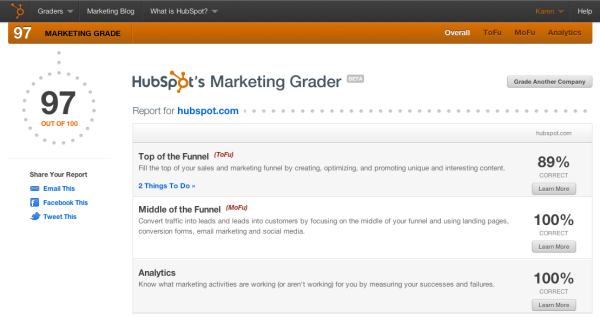If your organization uses Salesforce or another CRM system, you probably know that it's a powerful piece of software that is capable of transforming every aspect of how your sales team works. An effective CRM system can help your reps identify, manage, and close more deals more quickly. But with great power often comes great responsi-- err, complexity.
For many of us marketers, our CRM system is like a black box. We know it’s chock full of data that could be useful to us, and we have a sense that we don’t know enough about it, but we still don’t know how to get our bearings. Perhaps you feel like you're neck deep in CRM terminology every time you have a conversation with your sales manager. Maybe you just don't feel all that confident navigating through your CRM system, or maybe you know that as a marketer, you could get a lot more out of knowing it better.
While different CRM systems use slightly different terminology, to ease you into a better understanding of CRMs, let's take a look at some common CRM, and specifically, Salesforce terminology that marketers should know.
A
Account
A standard object in Salesforce that represents a company or organization (but not necessarily a customer). An account may have contacts (individuals or employees who work there), opportunities (potential sales deals), and other objects associated with it. The contact record stores details about the company like the company name, address, etc.
Activities
Records stored on an object that are typically used to represent actions taken on a lead, contact, or account -- things like phone calls, emails from a rep, or future tasks that a rep intends to complete. Many marketing software platforms can automatically insert activities into the activity history to give a rep context about key actions marketing is taking with respect to a lead (e.g. email sends, if those emails were opened or clicked, form submissions made by the lead, etc.).
Activity History
A list stored on a record in Salesforce that shows the history of activities that have been carried out on that object. For example, the activity history section on a contact record may contain a list of actions the sales rep has taken in working that lead -- emails sent, calls made, etc.
API
An API (application programming interface) is a system used by a piece of software to talk to other pieces of software. Salesforce offers an API that allows it to be connected to outside systems like a marketing platform or email tool. Some third parties ( like HubSpot ) have standard “connectors” that makes it possible to connect them to Salesforce’s API easily and without any technical knowledge.
Apex
A programming language used by developers to build applications that interact with Salesforce. These applications are often hosted on the Force.com platform (see below); there are hundreds of generally available applications in the Salesforce AppExchange.
AppExchange
Salesforce’s app marketplace, which contains hundreds of integrations with third-party services that allow users to extend the functionality of their Salesforce instance.
B
Bi-Directional Sync
A feature of a third-party tool (like HubSpot) that allows it to both read information from, and write information to, Salesforce. (Example: Because HubSpot’s Salesforce integration features bi-directional sync, it can both add new leads to Salesforce, and pull leads from Salesforce based on a user's preference.)
C
Campaign
An object in Salesforce used to track a marketing effort. The campaign object houses several standard pieces of data -- a campaign name, start and end dates, expected revenue, budgeted and actual costs, and more. While Salesforce campaigns have many uses, most marketers use them for reporting purposes. Campaigns are often used in conjunction with closed-loop reporting from a marketing software platform like HubSpot.
Chatter
A set of collaboration tools that are woven throughout Salesforce, allowing individuals to work together and share information on deals they are working. Users can join different groups, comment on different objects and data, and share details through chatter.
Closed-Loop Reporting
A reporting methodology in which data about which leads/contacts/accounts ultimately convert into sales is passed back to a marketing platform. In the marketing platform, the marketer can then attribute that customer to the various marketing efforts they touched, and better understand the ROI each of those efforts generated.
Closed Won Opportunity
A standard stage in Salesforce that refers to the status of an opportunity. An opportunity is typically set to “closed won” status when a deal is closed and the associated account is now a customer. Systems like HubSpot listen for this “closed won” status in Salesforce to enable closed-loop reporting.
Connector
A piece of software that connects another system (like a marketing software platform, or an email tool) to Salesforce.
Contact
A standard object in Salesforce that represents an individual person. The contact record contains details like a name, address, email, and phone number. A contact can be attached to an account and opportunity record.
Contact Role
A standard field included on the contact record that can be used to define the role an individual plays in an account or opportunity (e.g. decision maker, influencer, etc.).
Custom Field
A specialized piece of data stored in Salesforce that is unique to the user’s business. (e.g. A dog food manufacturer might create a custom field for “favorite dog breed” in its system to track the favorite breed of each of its contacts.)
Custom Object
A specialized type of record in Salesforce created to meet the needs of an individual business. An example of this might be an “employee” object that contains several details about an employee that is used by an HR department.
Custom Report
A view of data in Salesforce that has been personalized by the user to include exactly the information they want to see. A custom report might use filters to determine which records it includes (e.g. this report should include only lead records in Massachusetts who are CEOs) and will contain a set of individually chosen fields, usually as columns (e.g. the name, email address, and lead score of those Massachusetts CEO leads).
D
Dashboard
A dashboard in Salesforce is a graphical representation of what you might find in a report. Dashboards might include charts, gauges, or other graphics that represent the metrics that underly them. They make it easy for a team to track progress toward a goal or metric.
F
Field
A field in Salesforce is a piece of data stored on an object. An example of a field might be the “First Name” or “Email Address” field found on the lead and contact records. Fields are also often referred to as “properties.”
Force.com
A cloud platform service that allows developers to build and host applications on Salesforce’s servers. Force.com is widely used to host applications that work in conjunction with Salesforce, like many of the apps available in the Salesforce AppExchange.
Forecast
Generally speaking, a forecast is an estimate of revenue that will be brought in during a given time period. In the context of Salesforce, a forecast is a type of report that shows a tally of data from opportunities expected to close in a specified time period. Your sales managers may use Salesforce forecasts to monitor their pipeline throughout the month.
Formula Field
A formula field in Salesforce is similar to a cell in Excel that contains a formula. The field relies on an equation to populate the data it shows. That equation may take other fields or information into consideration. An example of a formula field might be a field that shows the number of days since sales last followed up with a specific lead.
L
Lead
A standard object in Salesforce that represents an individual identity at an early stage in the sales process. A lead record isn’t natively connected to other data in Salesforce, but is “converted” when it represents a valid opportunity (a process which creates a contact in its place, and associates it with account and opportunity records).
Lead Scoring
A process typically carried out in a marketing platform that assigns a numeric value to a lead to represent how qualified he/she is. Every organization typically devises its own scoring criteria based on factors that determine the likelihood that a lead is well qualified.
Lookup
A field that references the data in another field, possibly on another object. A lookup field can be identified by the clickable magnifying glass icon that appears alongside it. An example of a standard lookup field is the “Account” field that appears on a contact -- this field is set to reference the “Account Name” field on the associated account object.
M
Marketing Cloud
A suite of social analytics tools offered as an add-on to Salesforce that helps large enterprise organizations monitor and leverage social media.
O
Object
In the context of Salesforce, an “object” is a type of record that Salesforce uses to store your data. There are several standard objects that every Salesforce instance comes with out of the box -- an account, a lead, an opportunity, a contact, and many more. It is also possible to set up custom objects to reflect custom pieces of data or custom parts of your process.
Opportunity
A standard object in Salesforce that represents a potential sales deal. An opportunity record typically contains details about the potential deal, like expected deal size (a dollar amount that cascades up to Salesforce forecasts), expected close date, probability, and opportunity stage.
Opportunity Stage
A standard field found on the opportunity object that is used to track the status of an opportunity. The opportunity stage may be set to one of several values such as “Prospecting”, “Negotiation/Review,” or “Closed Won,” which represents that the opportunity is associated with a customer or won business.
Q
Queue
A queue in Salesforce is akin to a “holding pen” for objects that aren’t yet assigned to an individual. An example might be a “Recycled Leads Queue” where your sales reps send unqualified leads to if they determine the lead isn’t ready for sales contact.
R
Report
A report is what it sounds like -- a view in Salesforce of a specific subset of records and fields of data. Salesforce comes with several standard report types out of the box (e.g. the Campaign ROI Analysis Report, or the Lead History Report). It is also possible to create custom reports in Salesforce.
S
Standard Object
A type of record where data is stored that Salesforce uses out of the box. Examples of a standard object might be a lead object, a contact object, an account object, or an opportunity object. Also see the definition for “object.”
T
Task
Tasks in Salesforce represent an action that has been taken or will be taken with respect to a record in Salesforce. An example of a task might be a phone call to a lead, or a marketing email that was sent to and opened by a contact. Tasks are listed on individual records, and are used by sales reps to manage their day-to-day actions for each lead. Managers can track tasks to measure the activity of a rep via reports.
Trigger
A piece of Apex code that is used to kick off actions in Salesforce when a change to a record, or creation of a new record, happens in Salesforce. An example use of a trigger might be to change the “company type” field on an account record to “enterprise” if an account is set to have more than 500 employees in its company size field.
V
View
Think of a view as a predefined set of filter criteria that can be applied to a list of data from a drop-down menu. Many lists of data come with a preset list of helpful views; for example, you might choose to filter a list of contacts to see only “My Contacts,” which would surface a list of only contacts that you are set as the owner of. You can also create custom views in Salesforce.
W
Web to Lead
A tool in Salesforce that allows you to create simple forms that you can place on outside websites. When a user fills out the form, a lead is created in Salesforce. Note that most Salesforce Web to Lead forms will only accept up to 500 submissions per day.
Workflow Rule
A tool in Salesforce that allows you to automate certain actions like sending notification emails, updating fields in your database, adding tasks to a record in Salesforce, and more. An example use of workflow rules might be setting up a rule that sends an email to a specific sales manager when a deal comes in that needs their approval, based on the company size (or any other characteristic) of the associated opportunity.
Don't Be Overwhelmed!
While there are many terms you’ve probably heard used in reference to your particular CRM system, it’s important to not be overwhelmed. By biting off small bits and learning more and more from this CRM and Salesforce glossary , you’ll get a better understanding of the system your sales team uses every day, and how you can better leverage its capabilities to improve your marketing and your processes.
Image Credit: JD Hancock
Marketing Resources












![Ready to Play Some Business Babble Bingo? [Free Customizable Bingo Cards]](http://cdn2.hubspot.net/hub/53/file-61804964-png/Blog-Related_Images/business-babble-bingo-image.png)